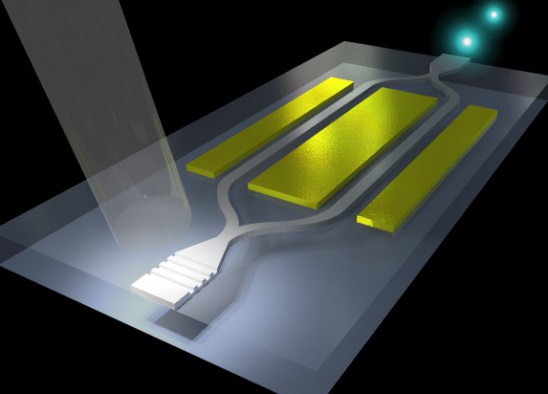November 10, 2014
Researchers at UCF’s College of Optics and Photonics (CREOL) have developed a novel platform and optical modulators at the difficult and less-explored wavelength range of mid-infrared. The platform can facilitate breakthroughs in the fields of free-space optical communications, environmental monitoring, sensing and biomedicine.
The work was conducted by Ph.D. student Jeff Chiles in professor Sasan Fathpour’s research group and was recently published in “Optica,” a peer-reviewed publication from The Optical Society that emphasizes high-impact scientific and technology innovations in optics and photonics.
A key aspect of light is the wavelength of the electromagnetic wave associated with it. The visible color range of light 380 to 700 nanometer wavelengths; the invisible light that is shorter wavelengths is ultraviolet, and the longer wavelengths is infrared. The infrared spectrum has several divisions, the most widely studied of which are the near- and short-infrared regimes. These wavelengths are the realm of optical-fiber telecommunications (telecom), without which the internet and high-speed telecom would not exist.
The longer, mid-infrared wavelengths – loosely defined as 3 to 5 micrometers – are another range covering bands of low-loss optical transmission in the atmosphere. This range also covers the absorption spectrum of vibrational modes of organic molecules, whose signature absorption resonances can be used for environmental monitoring, biological sensing, etc. Also, water absorbs light strongly at certain wavelength bands in the mid-infrared and the corresponding photoablation process in tissues has potential applications in skin surgery and dentistry.
Mid-infrared has been one of the least-developed wavelength regimes, however. It is a difficult range due to certain physical limitations, and hence both optical sources and detectors that can operate at these wavelengths are very difficult to achieve. Progress has been made in this regard in the past decade or so and decent quantum-cascade lasers and uncooled photodetectors have been developed.
Another key photonic device for system applications is optical modulators and that is what CREOL researchers have demonstrated for the first time. Optical modulators are, in essence, light switches needed to turn light off and on in order to transmit data in a communication link at very high speeds.
Standard waveguide and modulator platforms developed for shorter wavelengths do not work properly at mid-infrared wavelengths for a variety of reasons. To achieve mid-infrared optical modulators, Chiles bonded a thin film (220 nanometers thick) of silicon to a lithium niobate wafer by a novel technique. Lithium niobate is an exotic compound of niobium, lithium and oxygen and has a strong electro-optic effect useful for ultrafast modulators. The silicon-on-lithium-niobate (SiLN) was then used as a platform to fabricate optical waveguides and modulators at CREOL’s nanofabrication facility, an advanced UCF multiuser laboratory equipped with state-of-the-art tools such as electron-beam lithography. The fabricated modulators were then characterized by pumping light in and out of the photonic chips at the mid-infrared wavelength of 3.39 micrometers showing satisfactory performances.
The work is funded under the Office of Naval Research Young Investigator Program and the National Science Foundation CAREER Program.
“One of the best things about our research group is our willingness to keep pushing the boundaries in photonics,” Chiles said. “It’s a lot of work to create a new photonic platform. We could have settled with the conventional material platforms already available, but they still had many unsolved problems and missing features. The SiLN platform enables new mid-infrared devices that were not practical to make before. The whole project took place at CREOL – the concept, design, fabrication and measurement, and the result is a testament to the excellent facilities we have available.”
Chiles holds a UCF Trustees Doctoral Fellowship and won the IEEE Photonics Society 2014 ummer Topical Meeting student paper award on related research.
“We had previously demonstrated the first lithium-niobate thin films on silicon wafers to drastically improve the performance of modulators in the near- and short-infrared regimes,” Fathpour said. “What Jeff has brilliantly done is to flip the argument over and put silicon thin films on lithium-niobate wafers. It is probably not the only way to get modulators in the mid-infrared, but this approach has several advantages including the possibility of doing nonlinear optics on the same chip and taking advantage of the strong electro-optic effect in lithium niobate yet achieving very compact devices”.
The researchers are doing additional work to characterize the devices at higher speeds. The challenge is the availability of high-speed photodetectors in the mid-infrared. They also would like to investigate the nonlinear optical properties of the demonstrated waveguide platform for attaining light at wavelengths other than the input of the laser source, a phenomenon known as wavelength conversion.













